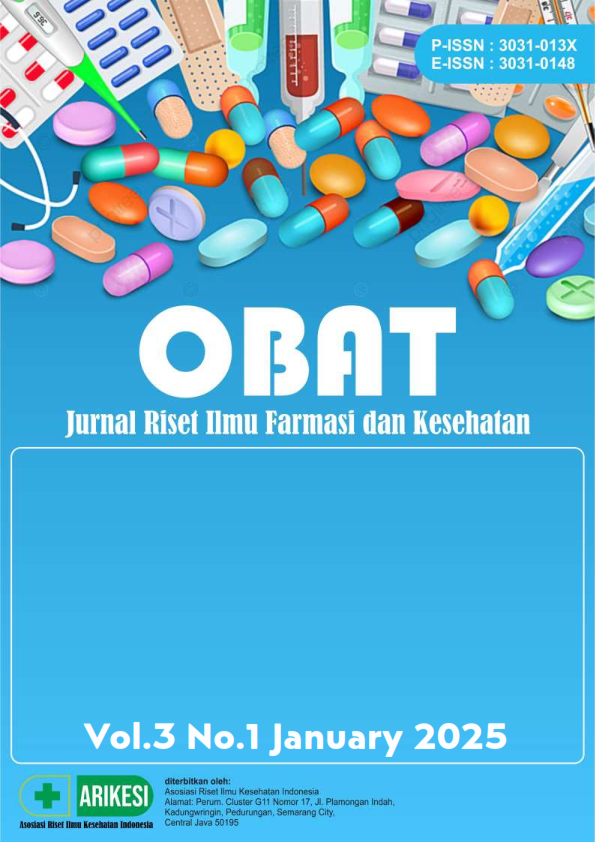Effect of Some Types of Anticoagulants on Some Biochemical Parameters of Plasma In Atherosclerosis Disease
DOI:
https://doi.org/10.61132/obat.v3i1.1027Keywords:
Anticoagulant, Dyslipidemia, Atherosclerosis, BiomarkersAbstract
This study investigated the influence of anticoagulant therapy on biochemical parameters and vascular function in patients with mixed dyslipidemia and asymptomatic atherosclerosis. Twenty-five participants were divided into two groups: a study group (SG) of 15 patients with mixed dyslipidemia and a control group (CG) of 9 healthy individuals. Baseline characteristics, including lipid profiles, inflammatory markers (osteopontin, osteoprotegerin, MMP-2, MMP-9), and clotting parameters, were assessed. The SG exhibited significantly elevated levels of total cholesterol, LDL cholesterol, non-HDL cholesterol, and triglycerides, alongside decreased HDL cholesterol and unexpectedly lower myeloperoxidase levels compared to the CG. Significant variability in biomarker levels was observed across quartiles within both groups. A strong positive correlation was found between serum TSH levels and Factor X activity, while a strong negative correlation was observed between serum TSH and PAI-1 antigen levels in patients with subclinical hyperthyroidism. Clotting times, assessed using the thromboplastin generation test with inosithin, did not reveal significant differences between venous and arterial samples or between the study and control groups based on the provided data. Further research incorporating quantitative clotting time analyses and a more comprehensive assessment of anticoagulant effects is needed to elucidate the complex interplay between anticoagulant therapy, dyslipidemia, and atherosclerosis.
Downloads
References
Ahmed, A. (2024). Primary prevention of stroke in high stroke risk populations: Examining impact of modifiable risk factors and risk stratification in older adults and South Asians using two longitudinal cohorts. UCL (University College London).
Berberich, A. J., & Hegele, R. A. (2022). A modern approach to dyslipidemia. Endocrine Reviews, 43(4), 611–653.
Bocchino, P. P., Angelini, F., & Toso, E. (2021). Atrial fibrillation and coronary artery disease: A review on the optimal use of oral anticoagulants. Reviews in Cardiovascular Medicine, 22(3), 635–648.
Gebreegziabiher, G., Belachew, T., Mehari, K., & Tamiru, D. (2021). Prevalence of dyslipidemia and associated risk factors among adult residents of Mekelle City, Northern Ethiopia. PLOS ONE, 16(2), e0243103.
Ghobish, A. M., El-Nokrashy, A. M., Elshafey, E. E., & Tayel, A. A. (2025). Investigating the potential of chitosan-nanocomposites as a bio-based adsorbent for sustainable aflatoxin eradication from fish feed. Egyptian Journal of Veterinary Sciences.
Guo, F., Gong, Z., Fernando, T., Zhang, L., Zhu, X., & Shi, Y. (2022). The lipid profiles in different characteristics of women with PCOS and the interaction between dyslipidemia and metabolic disorder states: A retrospective study in Chinese population. Frontiers in Endocrinology, 13, 892125.
Hong, N., Lin, Y., Ye, Z., Yang, C., Huang, Y., Duan, Q., & Xie, S. (2022). The relationship between dyslipidemia and inflammation among adults in East Coast China: A cross-sectional study. Frontiers in Immunology, 13, 937201.
Ilg, W., Milne, S., Schmitz-Hübsch, T., Alcock, L., Beichert, L., Bertini, E., Mohamed Ibrahim, N., Dawes, H., Gomez, C. M., & Hanagasi, H. (2024). Quantitative gait and balance outcomes for ataxia trials: Consensus recommendations by the Ataxia Global Initiative working group on digital-motor biomarkers. The Cerebellum, 23(4), 1566–1592.
Jannati, S., Patnaik, R., & Banerjee, Y. (2024). Beyond anticoagulation: A comprehensive review of non-vitamin K oral anticoagulants (NOACs) in inflammation and protease-activated receptor signaling. International Journal of Molecular Sciences, 25(16), 8727.
Kosowski, M., Basiak, M., Hachuła, M., & Okopień, B. (2022). Plasma concentrations of new biochemical markers of atherosclerosis in patients with dyslipidemia: A pilot study. Medicina, 58(6), 717.
Liu, H., & Peng, D. (2022). Update on dyslipidemia in hypothyroidism: The mechanism of dyslipidemia in hypothyroidism. Endocrine Connections, 11(2).
Mackman, N., Bergmeier, W., Stouffer, G. A., & Weitz, J. I. (2020). Therapeutic strategies for thrombosis: New targets and approaches. Nature Reviews Drug Discovery, 19(5), 333–352.
May, J. E., & Moll, S. (2020). How I treat unexplained arterial thrombosis. Blood, 136(13), 1487–1498.
Mihaila, R. G. (2022). Warfarin involvement, in comparison to NOACs, in the development of systemic atherosclerosis. Biomedical Papers of the Medical Faculty of Palacky University in Olomouc, 166(2).
Noushad, S., Ahmed, S., Ansari, B., Mustafa, U.-H., Saleem, Y., & Hazrat, H. (2021). Physiological biomarkers of chronic stress: A systematic review. International Journal of Health Sciences, 15(5), 46.
Rao, H., Jalali, J. A., Johnston, T. P., & Koulen, P. (2021). Emerging roles of dyslipidemia and hyperglycemia in diabetic retinopathy: Molecular mechanisms and clinical perspectives. Frontiers in Endocrinology, 12, 620045.
Rigutini, A. G., & Investigators, R. N. (2024). The impact of atherosclerotic burden on vascular outcomes in patients with stroke and atrial fibrillation: The ATHENA study. Clinical and Applied Thrombosis/Hemostasis, 30, 10760296241240746.
Roumeliotis, S., Dounousi, E., Salmas, M., Eleftheriadis, T., & Liakopoulos, V. (2020). Vascular calcification in chronic kidney disease: The role of vitamin K-dependent matrix Gla protein. Frontiers in Medicine, 7, 154.
Tall, A. R., Thomas, D. G., Gonzalez-Cabodevilla, A. G., & Goldberg, I. J. (2022). Addressing dyslipidemic risk beyond LDL-cholesterol. The Journal of Clinical Investigation, 132(1).
Totoń-Żurańska, J., Mikolajczyk, T. P., Saju, B., & Guzik, T. J. (2024). Vascular remodelling in cardiovascular diseases: Hypertension, oxidation, and inflammation. Clinical Science, 138(13), 817–850.
Vega-Rosales, J. A., Saucedo-Orozco, H., Márquez-Velasco, R., Cruz-Soto, R., Zazueta-Salido, D. F., Koretzky, S. G., Salinas-Arteaga, G., Guarner-Lans, V., Pech-Manzano, L., & Pérez-Torres, I. (2024). The role of the osteoprotegerin/RANKL/RANK axis and osteopontin in acute coronary syndrome. Archivos de Cardiología de México.
Wang, W., Fan, W., Su, Y., & Hong, K. (2023). A comparison of the effects of NOAC and VKA therapy on the incidence of dementia in patients with atrial fibrillation: A systematic review and meta-analysis. Clinical Cardiology, 46(8), 866–876.
Downloads
Published
How to Cite
Issue
Section
License
Copyright (c) 2025 OBAT: Jurnal Riset Ilmu Farmasi dan Kesehatan

This work is licensed under a Creative Commons Attribution-ShareAlike 4.0 International License.





